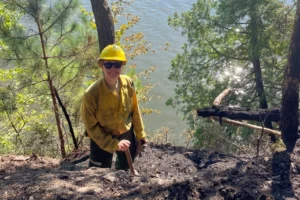Over the past decade, wildfires have become more common and more severe. The Camp Fire in California in 2018 destroyed the towns of Paradise and Concow and was the costliest natural disaster in the world that year. Last year, Wisconsin was covered in haze for days as smoke from wildfires in Canada drifted across the United States. The Smokehouse Creek Fire in Texas in earlier this year burned more than 1 million acres of land over three weeks.
That’s why wildland firefighters like Elena Crownover have such important jobs. They are the first responders to remote areas whose job it is to keep small fires from turning into large ones, or to contain large fires so they can prevent the loss of property and life.
But Crownover isn’t just a firefighter. She’s also a student at UWM, set to graduate this May with a major in conservation and environmental science.
“(My classes) have helped me understand how natural processes work and how fire plays a role in those processes,” she said. “Learning this stuff has given me more confidence, especially confidence in my ability to communicate with my coworkers and make decisions.”
Getting an education
Crownover is a nontraditional student. She tried her hand at college before leaving for a job as a wildland firefighter with the Wisconsin Department of Natural Resources, where she also worked as a fire program staff specialist. She loved the work because it let her spend time outdoors, and it’s a job that has a direct and positive impact on people’s lives. But, as she gained experience over three years and spoke with her colleagues, Crownover realized that she wanted to go back to the classroom to bolster her knowledge base.
So, she dropped her work as a staff specialist and enrolled in UWM’s CES program. Now in her second year of college, she is set to graduate this month.
Crownover says she’s received a solid education from UWM, especially in her CES Capstone class.
“We get an opportunity to go across the Milwaukee area and visit with natural resource professionals. We also have our capstone project where we are assigned with a local organization and we create a planting plan or a land management plan for them,” Crownover explained. “It’s a great opportunity for students to practice some of these skills that we will need in the work place, but in a safe environment where we’re still able to make mistakes.”
For her capstone project, Crownover is working with the Aldo Leopold Foundation to make a planting plan for prairie restoration. She and her project partner, Hassan Richardson, are in the process of wrapping up their work and will present it to the foundation for approval. If all goes well and their plan is implemented, Crownover could soon walk in a field full of plants that she selected.
Learning on the job
While she’s been taking classes, Crownover has also kept working as a wildland firefighter. In fact, she was able to count her job as an internship credit this past semester. While the knowledge she’s gained at UWM has been valuable, she’s learned a lot in the field, too.
Wildland firefighters with the Wisconsin DNR are responsible for suppressing any wildfires that break out in the state. They also handle prescribed burning, which is when firefighters intentionally set fires for ecological purposes.
“Just this past weekend, we did some burns in the southeastern part of the state,” she said. “There is a prairie down there that we just burned, and they’re trying to convert that wetland area back to its original oak savannah ecosystem. We use prescribed burning to help manage these different areas across the state.”
Prescribed burning is also a method to prevent forest fires.
For many years, Crownover explained, people thought that the best way to prevent a wildfire was to make sure that nothing in the forest burned. But, that meant that forest debris – dried leaves, sticks, fallen trees and the like – piled up over decades. As climate change has produced warmer, dryer summers, that debris becomes the perfect kindling to feed an inferno.
“So prescribed burning can help in a controlled way to get rid of some of that fuel so that we can prevent these big wildland fires that we see on the news,” Crownover said.
Of course, the work is dangerous. Wind can shift a wildfire in an instant, putting firefighters in harm’s way. There’s the risk of vehicle accidents – the water that firefighters carry in their vehicles can unbalance their load and lead to wrecks – and the chemicals found in diesel, gas, and fire suppressant materials can cause long-term health problems.
So why take on such a hazardous job?
“I feel called to be a part of helping protect different communities from these big tinder boxes, and hopefully, with the frequency and intensity of these fires, help stop them and spread the word about managing our lands and about wildland fires,” Crownover said.
After she graduates, she plans to spend the summer on a wildland firefighting crew in Washington State. From there, she hopes to join the U.S. Forest Service so she can help with land management and fire prevention all year round.
By Sarah Vickery, College of Letters & Science
